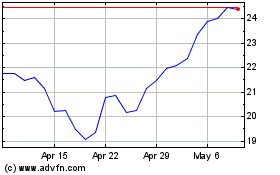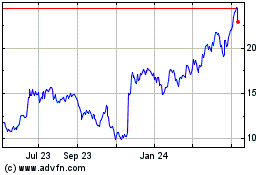By Taos Turner
NEUQUÉN, Argentina--From North Dakota to Texas and beyond, oil
and gas companies have sharply reined in drilling and thousands of
workers are being laid off.
But here, where the oil and gas industry operates inside a
government-made, subsidized bubble, taxpayers and drivers spend
billions of dollars to try to keep that from happening. A barrel of
oil fetches more than twice what it does in the U.S., and prices
for natural gas can be nearly four times higher.
That is helping shield producers and their workers developing
the vast shale oil-and-gas deposits buried under a desolate swath
of western Patagonia called Vaca Muerta, or Dead Cow, from the
vagaries of world markets.
Since taking office in December, Argentina's president, Mauricio
Macri, has been reversing the populist policies of his predecessor,
Cristina Kirchner, undoing everything from currency controls to
export taxes. But he is expanding the expensive programs she used
to decouple energy prices from global markets.
"This is so important, strategically," said Miguel Galuccio,
chief executive of Argentina's state-run oil company, YPF SA. With
the price of light crude set at $67 a barrel and natural gas at
$7.50 per million British Thermal Units--compared with less than $2
in the U.S.--the policy has made Argentina one of the few places on
Earth where energy companies are looking to expand their
operations.
Some energy analysts say the country's high production costs
make the system sustainable. But proponents here note that since
December, Dow Chemical Co. and American Energy Partners LP--which
had been run by Aubrey McClendon, the shale-drilling pioneer who
died earlier this month--have said they plan to invest in a
partnership with YPF to develop shale oil and gas. YPF also has
said it plans soon to form a joint venture with Russia's PAO
Gazprom.
"You've got to incentivize people to do exploration and
development, especially when prices are low," said Ali Moshiri,
president of Latin America and Africa for Chevron Corp., which has
an exploration-and-production joint venture with YPF. "If Argentina
carries on with these incentives, it will encourage others to come
to the country."
In this arid patch of Patagonia, YPF is running 350-ton drilling
rigs that dig 9,000 feet deep in search of gas. Far below red rocks
and desert scrub lie 27 billion barrels of technically recoverable
oil and 802 trillion cubic feet of gas trapped in a layer of shale
up to 1,200 feet thick, according to the U.S. Energy Information
Administration.
In one area of El Orejano, Argentina's flagship shale
gas-project, so many blue fracking-fluid pipelines crisscross the
ground that workers from YPF and Schlumberger Ltd., the
Houston-based oil service giant, have to take care not to stumble
over them. Tanks supply water that is mixed with chemicals and sand
and then blasted at high pressure into rock formations below,
fracturing and releasing gas.
"If we could tap just 7% of the resources we have in Vaca
Muerta, we could double Argentina's gas production," Pablo
Bizzotto, who runs YPF's regional unconventional operations, said
from inside a trailer where technicians used laptops to control a
drill snaking toward the shale.
World-wide, oil-and-gas companies cut capital spending by about
20% last year, with spending falling by as much as 40% in the U.S.,
according to Moody's Investors Service.
YPF increased spending by about 4%.
"It shows the government's strong desire to boost domestic oil
and gas production and maintain employment," said Matt Blomerth, an
analyst at energy consulting firm Wood Mackenzie.
This doesn't mean Argentina is immune to the global slowdown.
The number of working rigs was down 39% from a year earlier in
February, according to Baker Hughes Inc. Companies here have laid
off or furloughed workers, and YPF plans to cut spending by up to
25% this year. But the drop in rigs hasn't been as dramatic in the
U.S., where it fell 59% from a year earlier.
The government is also working to protect Argentina from the
kind of mass layoffs that have hit the industry world-wide. More
than 319,000 jobs have disappear since 2014, according to Graves
& Co., an energy-transaction-advisory firm.
"If you lower the price to a certain point, it's not like you
lose a rig or two, but you cause a pretty big shutdown and you lose
a lot of jobs," said Chris Boswell, chief executive of EcoStim
Energy Solutions Inc., a Houston oil-field-services company working
with YPF.
In January, Argentina's labor ministry agreed with unions and
Chubut, another oil-producing province, to artificially raise the
price of exportable heavy crude by $10 a barrel, to around $34, so
companies mining the tar-like oil don't lose more money. The
six-month deal could save 3,000 to 5,000 jobs, officials say.
"We are doing this to sustain activity and employment,"
Argentina's labor minister, Jorge Triaca, said last month.
Argentina spent $11 billion last year bolstering oil and gas
prices, according to an official estimate. Motorists here foot a
big part of that bill for the oil sector by paying about double
what U.S. drivers do for a gallon of gasoline. The government owes
almost $1.7 billion in back payments to companies for producing
natural gas.
For Fernando Navajas, who studies energy issues at FIEL, an
economic research firm, the data indicate the cost to produce a
barrel of oil is surpassing the subsidized rate. He said that is
"unsustainable, even in the best of cases," unless production costs
tumble and oil prices rebound.
Mr. Galuccio, however, says the prices keep YPF's shale
operations marginally profitable.
Argentine officials say they are banking on prices rising, so
they can eventually wean the country off price props.
"If you believe this price is going to stay at $20 for next 50
years, then what we're doing is wrong," said Mr. Galuccio, the YPF
CEO, who was appointed by Mrs. Kirchner in 2012 and will leave the
company in April, officials said Wednesday. "If prices rebound," he
said, "we are big winners."
Write to Taos Turner at taos.turner@wsj.com
(END) Dow Jones Newswires
March 09, 2016 18:52 ET (23:52 GMT)
Copyright (c) 2016 Dow Jones & Company, Inc.
YPF Sociedad Anonima (NYSE:YPF)
Historical Stock Chart
From Mar 2024 to Apr 2024

YPF Sociedad Anonima (NYSE:YPF)
Historical Stock Chart
From Apr 2023 to Apr 2024
